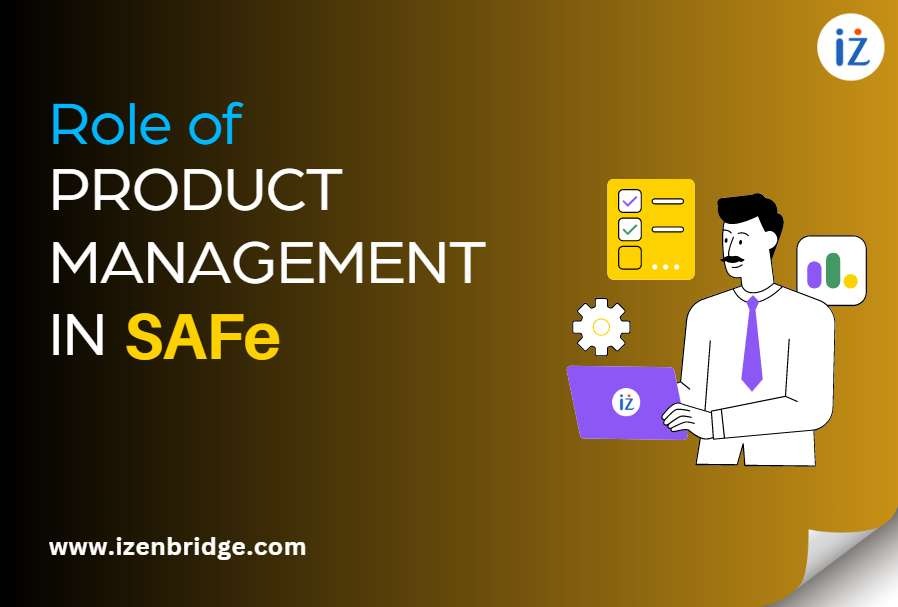

In agile development, the Scaled Agile Framework (SAFe) outlines a key role for Product Management (PM). The SAFe framework identifies five key areas that Product Management (PM) needs to excel in to deliver value continuously and drive the Agile Release Train (ART). Let’s dive into these categories in detail, but before we do that, it’s vital to grasp the overarching role of product management in the SAFe.
In a SAFe way of working, we establish something known as an Agile Release Train (ART). This ART consists of multiple Agile teams collaborating to deliver value continuously. It’s essential that the ART is supplied with the right requirements and priorities, allowing teams to focus and guarantee delivery of value to the end customer.
Product Management plays a key role in this process. One of the key responsibilities of this role is identifying and prioritizing items for the ART backlog. However, the role extends beyond just supplying backlog items. It’s also essential to monitor whether the value being delivered is on track and to make necessary adjustments when required. This ongoing process involves identifying, managing, validating, and updating features in the ART backlog continuously.
In any Agile Release Train (ART), there might be more than one Product Manager within the Product Management group. Sometimes, “Product Management” and “Product Manager” are used interchangeably, indicating that a single Product Manager could carry out the functions of Product Management. Conversely, in some instances, a team of Product Managers may be required to manage the process efficiently.
1. Exploring Market and Users
The first role involves understanding the customer segment we are targeting and conducting market research. Product management may conduct various surveys, use direct user inputs, or secondary database inputs to comprehend market trends. It’s about understanding the overall market rhythm, the competition, the expected release frequency, and the ebb and flow of demand.
2. Connecting with Customers
Understanding the segment leads us to empathize with our customers, understanding their needs and expectations. Product management works on a detailed analysis based on a customer-centric mindset, creating empathy maps, user journey maps, and continuously engaging with customers to comprehend their needs and expectations in the market segment where the organization operates.
3. Focusing on Solution Space
Product Management defines the product strategy, vision, and roadmap after understanding the customer segment and empathizing with their needs. The product strategy should align with the organization’s strategy and vision, and be focused on delivering value to the customer segment. Product management collaborates with stakeholders, business owners, system architects, and team-level product owners to ensure a coherent and effective vision and roadmap. SAFe Product Manager mentor and coach SAFe Product Owner (PO) to ensure execution aligns with strategy. To Know more about SAFe Product Owner, check our blog on “What Are the Roles & Responsibilities of a SAFe® Product Owner?”
4. Managing and Prioritizing ART Backlog
In the process of forming a strategic vision and roadmap, product management plays a vital role in refining features and collaboratively prioritizing the ART (Agile Release Train) backlog. A significant part of this role entails ensuring accurate communication of the intended purpose of each backlog item, which subsequently facilitates a comprehensive understanding of the requirements. Product Managers need to clearly grasp the SAFe (Scaled Agile Framework) principle, “Take an Economic View”. This principle underlines the importance of making decisions based on economic impact, and hence it’s essential for everyone involved in managing and prioritizing the backlog to adhere to this. The Weighted Shortest Job First (WSJF) method is employed for backlog prioritization to ascertain the most valuable tasks are undertaken first. Throughout the Program Increment (PI), the Product Manager continuously assesses the completeness of implemented features through the ART backlog. Although they are not directly responsible for technological decisions, Product Managers are vital in supporting the development and maintenance of the architectural runway. The Product Management’s participation also extends to various ART events.
5. Focusing on Delivering Value
The final role is about ensuring the developed features deliver value. This involves ensuring the readiness of the feature, making the new functionality familiar to the end users and operational staff, making it available, and providing necessary support. The product management role also involves monitoring how the new functionality is delivering economic value and validating the initial assumptions, aiding in refining the subsequent product development processes.
Becoming a highly effective SAFe (Scaled Agile Framework) Product Manager requires a combination of formal training, practical experience, key skills, and certain characteristics. Here are some steps and tips to consider:
Remember that becoming a highly effective SAFe Product Manager is a journey that involves continuous learning and improvement.
In conclusion, the role of Product Management within the Scaled Agile Framework (SAFe) is pivotal in driving the Agile Release Train (ART) and delivering continuous value. The five key areas identified for Product Management excellence – exploring the market and users, connecting with customers, focusing on the solution space, managing and prioritizing the ART backlog, and focusing on delivering value – present a comprehensive picture of the critical activities involved in this role. A highly effective SAFe Product Manager is not merely built through formal training and certifications; it requires practical experience, a deep understanding of the business and customers, strong communication and collaboration skills, and robust analytical and problem-solving abilities. These, combined with continuous learning and a strong adherence to the SAFe principles, can shape an effective SAFe Product Manager. Ultimately, the SAFe Product Manager plays an essential role in navigating the complexity of large-scale agile development, ensuring customer satisfaction, and achieving business objectives.
| Name | Date | Place | – |
| SAFe POPM Certification and Training | 18 – 19 January 2025 | India | More Details |
| SAFe POPM Certification and Training | 26 – 27 January 2025 | Bangalore | More Details |